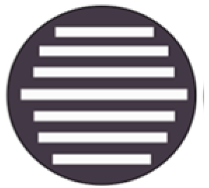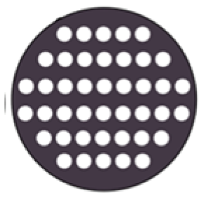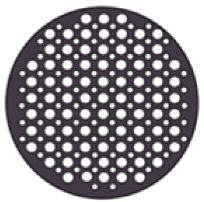Abstract
This study focuses on advancing sweat management in clothing using low-current operating textile electroosmotic pumps, which could be beneficial for microenvironments with restricted ventilation, such as the one between the skin and protective wear. These systems, employing silver–copper fabric electrodes, a polycarbonate membrane with microchannels, and an adhesive web, enabled directed liquid transport. The critical role of the adhesive layer preparation is emphasized, often overlooked in previous research. Various adhesive perforations were tested for their impact on the flow under current action, both with and against gravity. Specific adhesive application techniques are proposed, found to significantly influence the flow rate and textile assembly cohesion. The custom setup yielded flow rates of up to 8.8 ± 0.08 mg min−1 cm−2, suitable for diverse human sweat rates. Optimization hinges on the delicate balance between binding and the active surface areas of the adhesive.
1. Introduction
Textile electroosmotic pumps are textile systems that have been explored for the directed transport of liquids, relying on the electroosmotic phenomenon under low current action. Such systems are especially interesting for sweat management where ventilation and evaporation are restricted, such as in protective wear. Electroosmosis is an electrokinetic phenomenon that causes the movement of liquids through electrically charged surfaces, such as in the capillary walls or pores in microporous membranes, due to the presence of an electrical field [1,2]. When the microchannel walls of certain materials come in contact with a liquid, they can carry electrostatic charges, forming a double electrical layer (diffuse and compact layers), which can be dragged in a specific direction when there is an electrochemical potential difference across the microchannel. Electroosmosis can be passive, involving an intrinsic electroosmotic potential, or active, initiated by introducing an external potential difference. In the development of electroosmotic pumps, crucial components include a microporous material with microchannel walls capable of carrying electrostatic charges, and electrodes to create a potential difference across the membrane. Research has emphasized the importance of the thickness and diameter of the microchannels in achieving a short distance between the electrodes, essential for creating a strong electrical field to maximize the flow [1,3]. As electrodes, both conductive textiles and conductive thin films directly applied over the membrane using different deposition techniques have been explored [1,2,3,4,5,6,7,8,9,10,11,12]. Textiles offer the advantages of flexibility, breathability, and other wearability requirements, and can be metalized, made of conductive polymers, or a combination of both, each having its own set of pros and cons in the specific application.
This study concerns the development of textile electroosmotic pumps for sweat removal using silver–copper fabric combinations as electrodes, a polycarbonate membrane with microchannels to initiate the directional electroosmotic effect, and an adhesive web to join the layers together. The adhesive that binds the pump layers and its influence on the pump performance is highlighted in this research, since previous studies which used textiles as electrodes for an electroosmotic pump have not presented details on this step of the pump preparation.
2. Materials and Methods
2.1. Materials
As a microporous membrane, an ipPORETM track-etched hydrophilic polycarbonate (PC) membrane was obtained from it4ip S.A., Belgium. The conductive textile materials used as electrodes were obtained from Shieldex (Bremen, Germany). The adhesive layer was bought from www.destoffenkamer.be (accessed on 1 December 2022). The materials given in Appendix A, Table A1 have been used for creating each pump configuration. Four different adhesive configurations, designed in Inkscape, were laser-cut to create open areas for the liquid, which are presented in Table 1. The textile electrode materials and adhesive web were laser-cut into a circular shape (d = 40 mm), while the PC membrane was purchased in a circular shape with a diameter of 47 mm. Figure 1a shows the assembly of the layers forming the textile pump, and in Figure 1b, a step of the binding procedure is given, while more details are given in Appendix B.

Table 1.
Adhesive configurations and resulting surface area available for fluid transport.
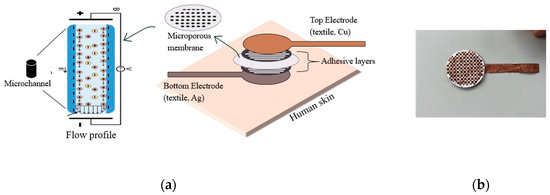
Figure 1.
(a) Textile electroosmotic pump assembly; (b) assembing an adhesive layer over one textile electrode for the heat press step.
2.2. Flow Test Setup in the Direction of Gravity
A test with a custom setup was conducted to determine the mass of fluid passing per unit of time under current and gravity action. The custom setup is given in Figure 2, while the test parameters are given in Appendix A, Table A2. The samples were clamped with the cathode facing downward; a deionized water–NaCl solution served as an electrolyte to simulate sweat and was mounted for continuous dripping over the samples. Prior to the voltage activation, the application of 1 mL of solution over the top (copper) electrode surface ensured that the top surface was wetted. The electrodes were connected to a DC power source and tested under a constant current, which was reached soon after activation, accompanied by a voltage drop. For 45 min, at each minute interval, the current, voltage, and mass of the flow collected on a glass plate below the clamped sample were monitored. A control sample was tested to check the influence of gravity on the resulting flow with no current.
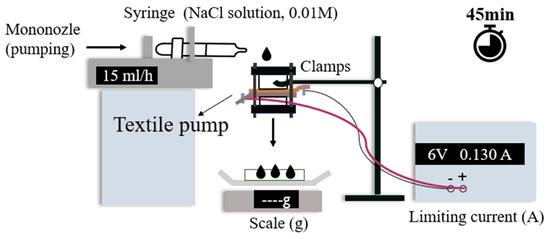
Figure 2.
Flow−rate test setup, under gravity and electrical current action.
2.3. Flow Test Setup in the Direction against Gravity
This evaluation was necessary to further understand the potential impact of gravity on the flow and the capability of the pumps to oppose gravitational forces. The sample was positioned with the copper (anode) side in contact with the NaCl droplets, while the silver (outer) side faced the air, upward. Both electrodes were connected to a DC voltage source. The current was not constant in this setup since the droplets did not fully cover the active surface area. A control test was undertaken without current to compare the results.
3. Results
3.1. Flow Test in the Direction of Gravity
The flow onset times and flow rate values are presented, calculated based on the data from the time of the flow onset on the other side of the pump to the end of the test. Normalized flow rate values (per cm2) were obtained by dividing the calculated flow rate (based on linear regression) by the surface area of the clamped pumps accessible to be covered by the liquid solution. The relationship between the active surface area created by the adhesive configuration and the resulting flow rate and the time of flow onset is better presented in Figure 3a, while the flow rate slopes of each pump configuration are shown in Figure 4.
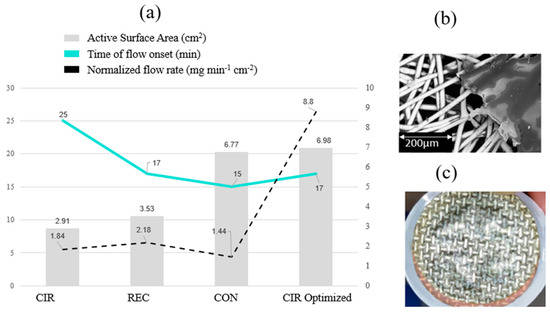
Figure 3.
(a) Active surface area of each adhesive configuration, resulting flow rate, and flow onset time from the 45 min flow test; (b) SEM of the melted adhesive over textile electrodes and free surface area; (c) swelling observed for CON configuration during the 45 min flow test.
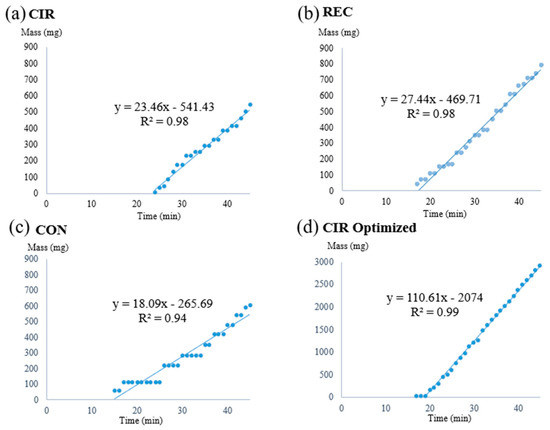
Figure 4.
Flow rate slope characteristics per pump configuration. The blue lines on the graph depict the linearized flow rate, while the blue dots represent the actual mass of flow per minute.
The onset flow time is the observed time when the liquid solution begins to flow through the other side of the pump and it needs to be minimized. The relation between the resulting active surface area and the time of flow onset is shown in Figure 3a. The configuration with the lowest active surface area of 2.91 cm2 has the slowest flow onset, but a larger increase in surface area may not necessarily result in a faster onset time, as REC shows values comparable to CIR Optimized and CON.
The shape and size of the perforations might influence the onset time and larger perforations can lead to a faster longitudinal spread of liquid. The binding area of the adhesive and its interconnection plays a role in the pump performance. CON, despite having a high active surface area, showed the lowest flow rate, which could be related to the occurrence of air gaps due to its large perforated areas, as visible in Figure 3c. The presence of air gaps could hinder the establishment of a high electric field, crucial for the initiation of electroosmotic flow.
A significant increase in the active surface area, as seen from Figure 3a and Figure 4, leads to a corresponding increase in the flow rate, since more pathways for fluid flow are provided. CIR Optimized, with a maximized interconnection of the adhesive layers and the largest active surface area, resulted in greater flow rate values compared to the other configurations.
The continuity of the flow rate slopes can be observed for each sample in Figure 4. The slope of CON displays occasional discontinuity over the testing duration, which could be related to the air gaps created by the large adhesive perforations. In contrast, the other configurations exhibit a consistent and uninterrupted flow rate with a linear increase in time (from the onset time onward).
During the test, it was observed that wetting of the outer surface of the pump begins much sooner before a drop actually falls down, which means that the liquid is being transported but tends to stick to the outer surface. The contact angle of the outer silver electrode measures 87.11° (Appendix A, Table A1), which is in close proximity to the 90° threshold that distinguishes hydrophilic from hydrophobic surfaces [7,13]. This may suggest the need to enhance the hydrophobicity of the outer surface to expedite the onset time in further studies [2].
3.2. Influence of Gravity on Flow
It was important to check the influence of gravity on flow in order to avoid false conclusions. In the “Against Gravity” test shown in Figure 5, an experiment was conducted to observe the upward flow of a 1 mL droplet of 0.01 NaCl water solution in the electroosmotic pump, specifically Circular Optimized, under a starting voltage of 6 V. It was noted that reverse flow occurred in the first 2–3 min of the test, indicated by the wetting of the silver electrode surface which continued to spread over the course of 10 min. The control sample without current action showed no wetting after 15 min. This suggests that the electroosmotic effect plays a significant role in the flow even when gravity acts against it.
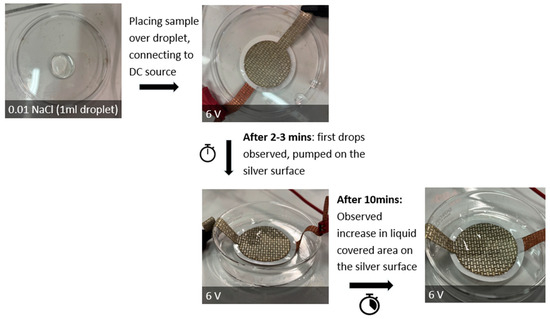
Figure 5.
Anti-gravitational flow observation in 10 min under voltage action.
4. Conclusions and Future Work
This study aimed to develop textile electroosmotic pumps for managing sweat in protective clothing, especially in situations where evaporation is restricted. The study achieved flow rates of up to 8.8 ± 0.08 mg min−1 cm−2, comparable to a previous study on protective clothing with a flow rate of 7.8 mg min−1 cm−2. The electroosmotic effect on facilitating flow, even against gravity, was confirmed, underscoring the critical role of current action in initiating flow. When adhesive binding is used to join the pump components, a careful design is essential to achieve a balance between the number, shape, size, and interconnection of the perforated openings through which the flow can pass. These factors directly influence the resulting flow rate and onset time. Future research avenues may explore the use of a pulsating current, which could potentially reduce rapid oxidation and power consumption. Additionally, increasing the pump’s wettability gradient could promote flow transport.
Author Contributions
Conceptualization, M.G. and B.M.; methodology, M.G.; software, M.G. and B.M.; validation, M.G., B.M. and A.M.; formal analysis, M.G. and B.M.; investigation, A.M.; resources, A.M.; data curation, A.M.; writing—original draft preparation, M.G.; writing—review and editing, B.M.; visualization, M.G.; supervision, B.M. and L.V.L.; project administration, L.V.L.; funding acquisition, L.V.L. All authors have read and agreed to the published version of the manuscript.
Funding
This research received no external funding.
Institutional Review Board Statement
Not applicable.
Informed Consent Statement
Not applicable.
Data Availability Statement
The data that support the findings of this study are available from the corresponding author, M.G., upon request.
Conflicts of Interest
The authors declare no conflicts of interest.
Appendix A

Table A1.
Materials used for the textile electroosmotic pumps.
Table A1.
Materials used for the textile electroosmotic pumps.
| Material Name | Function in the Electroosmotic Pump | Composition and Structure | Weight (g/m2) | Thickness (mm) | Surface Resistance (Ω/sq) | Average Surface Contact Angle (°) |
|---|---|---|---|---|---|---|
| Shieldex® Kiel + 30 | Top electrode (anode), thermally and electrically conductive. | Spun-bonded non-woven 100% Polyamide Nylon 6.6. Metal-plated with pure copper (48.65%). | 100 | 0.12 | <0.02 | 73.65 |
| Shieldex® Basel | Bottom electrode (cathode), thermally and electrically conductive. | Spun-bonded non-woven 100% Polyamide Nylon 6.6. Silver-coated, PA/Ag (75%/25%). | 38 | 0.25 | <1 | 87.11 |
| ipPORETM track-etched PC membrane | A microporous PC membrane with perpendicular microchannels between electrodes is needed to carry electrostatic charges between electrodes. | Hydrophilic microporous membrane with pore size of 0.0004 mm, porosity of 18.8%, and membrane diameter of 47 mm. | / | 0.025 | infinite | / |
| Vliesofix® Bondaweb 719 | Adhesive web to bind the electrodes and membrane together. | 100% PA | 70 | / | infinite | / |

Table A2.
Testing parameters for the flow test under gravity and current action for each electroosmotic pump configuration.
Table A2.
Testing parameters for the flow test under gravity and current action for each electroosmotic pump configuration.
| Sample Code | Initial Voltage (V) | Limiting Current (A) | NaCl-Water Solution (M) | Set Flow Rate of Solution (mL/h) | Initial NaCl Solution Drop * (mL) | Testing Time (min) |
|---|---|---|---|---|---|---|
| REC | 6 | 0.130 | 0.01 | 15 | 1 | 45 |
| CON | 6 | 0.130 | 0.01 | 15 | 1 | 45 |
| CIR | 6 | 0.130 | 0.01 | 15 | 1 | 45 |
| CIR Optimized | 6 | 0.150 | 0.01 | 15 | 1 | 45 |
* Drop of NaCl solution used for wetting the top electrode surface before starting the test and voltage activation.
Appendix B
Appendix B.1. Assembly of the Electroosmotic Pumps—Binding Procedure
The layers of the electroosmotic pumps were laminated together using a heat press machine with an optimal heat press procedure determined at 13C for 16 s. First, each textile electrode was individually heat-pressed with an adhesive layer under the specified conditions. Subsequently, the protective paper on the non-bonded side of the adhesive was removed. Following this, both electrodes were joined with the PC membrane in between, and the heat press procedure was repeated. Careful attention was given to placing the non-bonded adhesive side of the textile electrodes over each side of the PC membrane. In total, the heat-pressing process was repeated three times to create each pump configuration.
References
- Chandrasekhar, P.; Pirgov, P.; Zay, B.J.; Lawrence, D.; Morefield, S.; Rittenhouse, T.; Clementi, S.; Truong, Q.; Greene, R. Electroosmotic Water Vapor Transport across Novel, Smart, Functionalized Conducting Polymer Microporous Membranes in Active Mode at Very High Rates, with Concomitant Chemical Warfare (CW) Agent Blocking. Adv. Mater. Phys. Chem. 2013, 3, 217–237. [Google Scholar] [CrossRef]
- Zhang, Y.; Tian, M.; Wang, L.; Zhao, H.; Qu, L. Flexible Janus Textile-Based Electroosmotic Pump for Large-Area Unidirectional Positive Water Transport. Adv. Mater. Interfaces 2020, 7, 1902133. [Google Scholar] [CrossRef]
- Bengtsson, K.; Robinson, N. A large-area, all-plastic, flexible electroosmotic pump. Microfluid. Nanofluidics. 2017, 21, 178. [Google Scholar] [CrossRef]
- Sreenath, S.; Suman, R.; Sayana, K.; Nayanthara, P.; Borle, N.G.; Verma, V.; Nagarale, R.K. Low-Voltage Nongassing Electroosmotic Pump and Infusion Device with Polyoxometalate-Encapsulated Carbon Nanotubes. Langmuir 2021, 37, 1563–1570. [Google Scholar] [CrossRef] [PubMed]
- Bengtsson, K.; Christoffersson, J.; Mandenius, C.F.; Robinson, N.D. A clip-on electroosmotic pump for oscillating flow in microfluidic cell culture devices. Microfluid. Nanofluidics. 2018, 22, 27. [Google Scholar] [CrossRef]
- Hu, J.S.; Chao, C.Y.H. Development of an Electroosmotic Pump-Driven Micro LiBr Absorption Heat Pump System for Controlling Microclimate in Protective Clothing: Feasibility Review and Role of the Pump. HVACR Res. 2008, 14, 467–487. [Google Scholar] [CrossRef]
- Law, K.-Y. Water–surface interactions and definitions for hydrophilicity, hydrophobicity and superhydrophobicity. Pure Appl. Chem. 2015, 87, 759–765. [Google Scholar] [CrossRef]
- Snyder, J.L.; Getpreecharsawas, J.; Fang, D.Z.; Gaborski, T.R.; Striemer, C.C.; Fauchet, P.M.; Borkholder, D.A.; McGrath, J.L. High-performance, low-voltage electroosmotic pumps with molecularly thin silicon nanomembranes. Proc. Natl. Acad. Sci. USA 2013, 110, 18425–18430. [Google Scholar] [CrossRef] [PubMed]
- Tian, S.; Zhang, W.; Shi, J.; Guo, Z.; Li, M. A Performance-enhanced Electroosmotic Pump with Track-etched Polycarbonate Membrane by Allylhydridopolycarbosilane Coating. Anal. Sci. Int. J. Jpn. Soc. Anal. Chem. 2020, 36, 953–957. [Google Scholar] [CrossRef] [PubMed]
- Ai, Y.; Yalcin, S.E.; Gu, D.; Baysal, O.; Baumgart, H.; Qian, S.; Beskok, A. A low-voltage nano-porous electroosmotic pump. J. Colloid. Interface Sci. 2010, 350, 465–470. [Google Scholar] [CrossRef] [PubMed]
- Wu, X.; Ramiah Rajasekaran, P.; Martin, C.R. An Alternating Current Electroosmotic Pump Based on Conical Nanopore Membranes. ACS Nano 2016, 10, 4637–4643. [Google Scholar] [CrossRef] [PubMed]
- Kofler, M.; Lenninger, M.; Mayer, G.; Neuwirt, H.; Grimm, M.; Bechtold, T. Multi-chamber electroosmosis using textile reinforced agar membranes—A promising concept for the future of hemodialysis. Carbohydr. Polym. 2016, 136, 81–86. [Google Scholar] [CrossRef]
- Manoharan, K.; Bhattacharya, S. Superhydrophobic surfaces review: Functional application, fabrication techniques and limitations. J. Micromanuf. 2019, 2, 59–78. [Google Scholar] [CrossRef]
Disclaimer/Publisher’s Note: The statements, opinions and data contained in all publications are solely those of the individual author(s) and contributor(s) and not of MDPI and/or the editor(s). MDPI and/or the editor(s) disclaim responsibility for any injury to people or property resulting from any ideas, methods, instructions or products referred to in the content. |
© 2024 by the authors. Licensee MDPI, Basel, Switzerland. This article is an open access article distributed under the terms and conditions of the Creative Commons Attribution (CC BY) license (https://creativecommons.org/licenses/by/4.0/).
